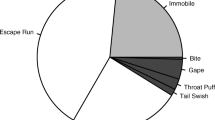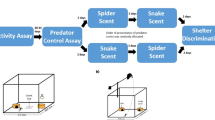Abstract
Vertebrates inhabiting islands are often characterized by fearlessness and tame behavior. While this relaxation of antipredator behavior has been documented in many species endemic to islands, fewer researchers have examined it in species that occur both in insular and mainland habitats. In addition, the mechanisms underlying this shift in behavior are still poorly known. For this work, antipredator behavior of island and mainland populations of the common gartersnake (Thamnophis sirtalis) was surveyed. Observed differences were explained in terms of innate tendencies and/or environmental influences using both neonates and adults in laboratory experiments designed to tease apart these two underlying mechanisms. While antipredator behavior of adults was positively correlated with the predation pressures associated with capture sites, neonate behavior did not fully reflect this pattern. However, some support for hard-wired antipredator behavior at birth was evident. Plasticity experiments also revealed that environmental factors appear to influence antipredator behavior. Thus, the data presented here suggest that predation pressures play a strong role in shaping the antipredator behavior of island animals and that the resulting behaviors are most likely the result of some combination of both nature and nurture.



Similar content being viewed by others
References
Aickin M, Gensler H (1996) Adjusting for multiple testing when reporting research results: the Bonferroni vs. Holm methods. Am J Public Health 86:726–728
Alcover JA, McMinn M (1994) Predators of vertebrates on islands. Bioscience 44:12–18
Atkinson I (1989) Introduced animals and extinctions. In: Western D, Pearl M (eds) Conservation of the twenty-first century. Oxford University Press, New York, pp 54–69
Aubret F, Bonnet X, Shine R (2007) The role of adaptive plasticity in a major evolutionary transition: early aquatic experience affects locomotor performance of terrestrial snakes. Funct Ecol 21:1154–1161
Aubret F, Michniewicz FJ, Shine R (2010) Correlated geographic variation in predation and antipredator behavior within a wide-ranging snake species (Notechis scutatus, Elapidae). Aust Ecol 36:446–452
Badyaev AV, Hill GE, Beck ML, Dervan AA, Duckworth RA, McGraw KJ, Nolan PM, Whittingham LA (2002) Sex-biased hatching order and adaptive population divergence in a passerine bird. Science 295:316–318
Beauchamp G (2004) Reduced flocking by birds on islands with relaxed predation. Proc R Soc Lond B 271:1039–1041
Blazquez MC, Rodriguez-Estrella R, Delibes M (1997) Escape behavior and predation risk of mainland and island spiny-tailed iguanas (Ctenosaura hemilopha). Ethology 103:990–998
Blumstein DT (2006) The multipredator hypothesis and the evolutionary persistence of antipredator behavior. Ethology 112:209–217
Blumstein DT, Daniel JC (2005) The loss of antipredator behavior following isolation on islands. Proc R Soc Lond B 272:1663–1668
Bonnet X, Aubret F, Lourdais O, Ladyman M, Bradshaw D, Maumelat S (2005) Do ‘quiet’ places make animals placid? Island vs. mainland tiger snakes. Ethology 111:573–592
Brodie ED III, Garland T Jr (1993) Quantitative genetics of snake populations. In: Seigel RA, Collins JT (eds) Snakes: ecology and behavior. McGraw-Hill, New York, pp 315–362
Brown WS, Parker WS (1976) A ventral scale clipping system for permanently marking snakes (Reptilia, Serpentes). J Herpetol 10:247–249
Burghardt GM (1993) The comparative imperative: genetics and ontogeny of chemoreceptive prey responses in natricine snakes. Brain Behav Evol 41:138–146
Burghardt GM, Schwartz JM (1999) Geographic variations on methodological themes in comparative ethology: a natricine snake perspective. In: Foster SA, Endler JA (eds) Geographic variation in behavior: perspectives on evolutionary mechanisms. Oxford University Press, New York, pp 69–94
Case TJ, Bolber DT, Richman AD (1992) Reptilian extinctions: the last ten thousand years. In: Fielder PL, Jain KK (eds) Conservation biology: the theory and practice of nature conservation, preservation. and management. Chapman and Hall, New York, pp 91–125
Coss RG (1999) Effects of relaxed natural selection on the evolution of behavior. In: Foster SA, Endler JA (eds) Geographic variation in behavior: perspectives on evolutionary mechanisms. Oxford University Press, New York, pp 180–208
Hatt RT, Tyne JV, Stuart LC, Pope CH, Grobman AB (1948) Island life: a study of the land vertebrates of the islands of eastern Lake Michigan. Cranbrook Press, Bloomfield Hills
Herzog HA Jr (1990) Experiential modification of defensive behaviors in garter snakes (Thamnophis sirtalis). J Comp Psychol 104:334–339
Herzog HA Jr, Burghardt GM (1986) Development of antipredator responses in snakes: I. Defensive and open-field behaviors in newborns and adults of three species of garter snakes (Thamnophis melanogaster, T. sirtalis, T. butleri). J Comp Psychol 100:372–379
Herzog HA Jr, Bowers BB, Burghardt GM (1992) Development of antipredator responses in snakes: V. Species differences in ontogenetic trajectories. Dev Psychobiol 25:199–211
Holm S (1979) A simple sequentially rejective multiple test procedure. Scand J Stat 6:65–70
Hough JL (1958) Geology of the Great Lakes. University of Illinois Press, Urbana
King RB (2002) Family, sex, and testosterone effects on garter snake behavior. Anim Behav 64:345–359
King RB, Milstead WB, Gibbs HL, Prosser MR, Burghardt GM, McCracken GF (2001) Application of microsatellite DNA markers to discriminate between maternal and genetic effects on scalation and behavior in multiply-sired garter snake litters. Can J Zool 79:121–128
Magurran AE (1999) The causes and consequences of geographic variation in antipredator behavior. In: Foster SA, Endler JA (eds) Geographic variation in behavior: perspectives on evolutionary mechanisms. Oxford University Press, New York, pp 139–163
McLaughlin JF, Roughgarden J (1989) Avian predation on Anolis lizards in the northeastern Caribbean: an inter-island contrast. Ecology 70:617–628
Mori A, Burghardt GM (2000) Does prey matter? Geographic variation in antipredator responses of hatchlings of a Japanese natricine snake (Rhabdophis tigrinus). J Comp Psychol 114:408–413
Mori A, Layne D, Burghardt GM (1996) Description and preliminary analysis of antipredator behavior of Rhabdophis tigrinus tigrinus, a colubrid snake with nuchal glands. Jpn J Herpetol 16:94–107
Orrock JL (2010) When the ghost of predation has passed: do rodents from islands with and without fox predators exhibit aversion to fox cues? Ethology 116:338–345
Pimm SL (1987) Determining effects of introduced species. Trends Ecol Evol 2:106–108
Placyk JS Jr, Burghardt GM (2005) Geographic variation in the frequency of scarring and tail stubs in eastern gartersnakes (Thamnophis s. sirtalis) from Michigan, USA. Amphib Reptil 26:353–358
Placyk JS Jr, Burghardt GM (2011) Evolutionary persistence of chemically elicited ophiophagous antipredator responses in gartersnakes, Thamnophis sirtalis. J Comp Psychol 125:134–142
Placyk JS Jr, Gillingham JC (2002) Biogeography of the herpetofauna of the Beaver Archipelago: a synthesis and reevaluation. Bull Chicago Herpetol Soc 37:210–215
Placyk JS Jr, Burghardt GM, Small RL, King RB, Casper GS, Robinson JW (2007) Post-glacial recolonization of the Great Lakes region by the common gartersnake (Thamnophis sirtalis) inferred from mtDNA sequences. Mol Phylogenet Evol 43:452–467
Rossman DA, Ford NB, Seigel RA (1996) The garter snakes: evolution and ecology. University of Oklahoma Press, Norman
Seigel RA, Collins JT (eds) (1993) Snakes: ecology and behavior. McGraw-Hill, New York
Seigel RA, Collins JT, Novak SS (eds) (1987) Snakes: ecology and evolutionary biology. McGraw-Hill, New York
Stone PA, Snell HL, Snell HM (1994) Behavioral diversity as biological diversity: introduced cats and lava lizard wariness. Conserv Biol 8:569–573
Acknowledgments
Special thanks to Jonathan P. Casey for a lifetime of support. I thank Gordon Burghardt, Sandy Echternacht, Chris Boake, and Randy Small for reviewing an earlier incarnation of this manuscript. Jim Gillingham of Central Michigan University (CMU) and Brent Graves of Northern Michigan University provided laboratory space, other facilities and supplies for the collection of snakes in Michigan. Gordon Burghardt of the University of Tennessee and his Reptile Ethology Lab provided space and support for the housing and care of pregnant females and neonates. The staff, students, and researchers of CMUs Biological Station on Beaver Island were invaluable in the collection of snakes and transport to sites. All snakes were collected under a Michigan Department of Natural Resources Scientific Collector’s Permit. Funding for this research was provided via Summer Research Grants from the Department of Ecology and Evolutionary Biology at the University of Tennessee and a National Science Foundation Doctoral Dissertation Improvement Grant (IBN 0309339).
Author information
Authors and Affiliations
Corresponding author
About this article
Cite this article
Placyk, J.S. The role of innate and environmental influences in shaping antipredator behavior of mainland and insular gartersnakes (Thamnophis sirtalis). J Ethol 30, 101–108 (2012). https://doi.org/10.1007/s10164-011-0302-0
Received:
Accepted:
Published:
Issue Date:
DOI: https://doi.org/10.1007/s10164-011-0302-0




